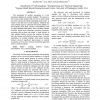Free Online Productivity Tools
i2Speak
i2Symbol
i2OCR
iTex2Img
iWeb2Print
iWeb2Shot
i2Type
iPdf2Split
iPdf2Merge
i2Bopomofo
i2Arabic
i2Style
i2Image
i2PDF
iLatex2Rtf
Sci2ools
ICASSP
2008
IEEE
2008
IEEE
Single sideband encoder for music coding in cochlear implants
The restoration of melody perception is a key remaining challenge in cochlear implants. We propose a new sound coding strategy that converts an audio signal into time-varying electrically stimulating pulse trains. A sound is first split into several frequency subbands and each subband signal is coherently downward shifted to a low-frequency base band, similar to demodulation used in single sideband (SSB) radios. These resulting coherent envelope signals have Hermitian symmetric frequency spectrums and are thus real-valued. A peak detector in each subband further converts the coherent envelopes into rate-varying and interleaved pulse trains. Acoustic simulations of cochlear implants with normal hearing listeners showed significant improvement in melody recognition over the most common stimulation approach used in cochlear implants.
| Added | 30 May 2010 |
| Updated | 30 May 2010 |
| Type | Conference |
| Year | 2008 |
| Where | ICASSP |
| Authors | Kaibao Nie, Les E. Atlas, Jay Rubinstein |
Comments (0)

